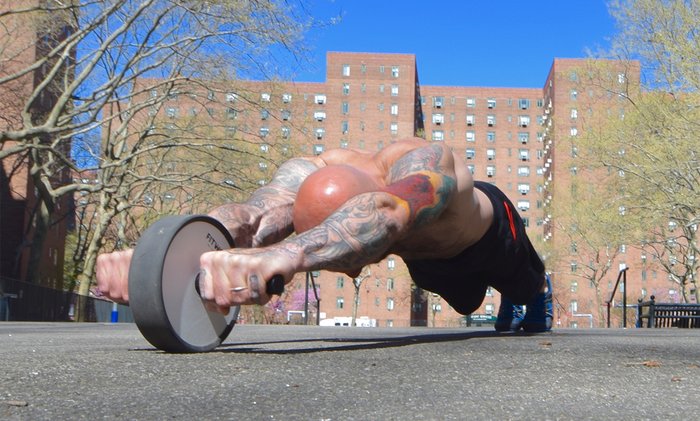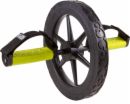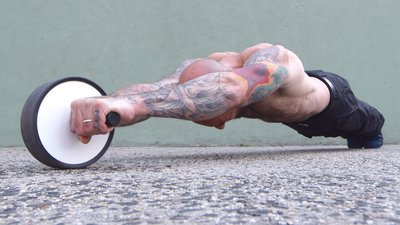My first sighting of an ab wheel was during a late-night TV ad I saw as a teenager. Savvy kid that I was, I knew to be cautious of any product advertised during the same commercial break as a Chia Pet or ShamWow, and this little circle with a handle stuck through the middle definitely looked too good to be true.
Unlike those other products, however, I would eventually change my opinion of the ab wheel. I'm a minimalist when it comes to workout equipment, and I love to train outdoors, so it's pretty rare that any exercise accessory fits my needs. The ab wheel, and a jump rope, are about as far as my toolbox goes.
Why the wheel? It's simply one of the best tools for building your abdominals, and can actually help facilitate a fantastic full-body workout. That's right: ab wheel exercises involve way more than just your abs. The emphasis is on the core muscle of the rectus abdominis, but you'll also need to engage your arms, shoulders, chest, back, glutes, and even your legs when you train with an ab wheel.
That's a big payoff for something that weighs next to nothing and costs less than lunch. Even if you're a bodyweight diehard, here's why you should consider rolling with the wheel.
Ab-natomy of Core Training
There are essentially two types of ab exercises: The first finds the abs performing some kind of trunk flexion. Crunches, sit-ups, and knee tucks are all examples of this type of ab exercise. The second type are exercises in which the abs are used primarily in a stability/anti-extension role. These include planks, hollow body holds, and front levers.
The classic ab-wheel roll-out gives you the best of both: It involves flexing and extending the trunk (like the exercises in the first category), but the most intense part of the movement happens when your body is extended horizontally, with the abs working in an anti-extension capacity (like the exercises in the second category). The farther you roll the wheel from your body, the more work your abs have to do in order to maintain a straight trunk. As you get closer to horizontal, the move becomes exponentially harder.

Your lower back is also a key player in performing ab-wheel roll-outs, acting as an antagonist to your abdominal muscles, and helping to provide additional stability for your spine. In fact, it is not uncommon for the lower back to fatigue before the abs when performing ab-wheel roll-outs, so be mindful of your lumbar region when performing this exercise. Be careful not to allow excessive arching of your lower back, as doing so can potentially cause injury.
The Wheel Deal
The full standing ab-wheel roll-out may very well be the single best exercise for developing your midsection, but you're going to have to work your way up to it by using some progressive variations. Newcomers to the ab wheel can start getting a feel for the instability it creates by simply holding an isometric plank on the wheel.
Get into a standard push-up position, only with your hands gripping the handles of the ab wheel instead of being placed on the floor. Maintain a straight line from the back of your head to your heels, with your shoulders packed into the sockets. It can be difficult to keep the wheel from tipping over, so focus on keeping your whole body tense to remain stable. Aim for a 30 second hold in this position. You may be surprised at first by how much more difficult the ab wheel makes this basic exercise.
If you aren't able to hold an ab-wheel plank on your toes yet, you can modify it by placing your knees on the ground instead. Either way, make sure to maintain a straight back the whole time, keeping your hips in line with your shoulders and legs.
Roll Out!
Once you've gotten comfortable with the ab-wheel plank, you're ready to safely begin practicing ab-wheel roll-outs.

Begin in a kneeling plank position, holding the ab wheel beneath your chest, then roll the wheel away from your body as you pivot from your knees, bringing your hips and torso down toward the ground as you extend your arms overhead. Once again, remember to avoid arching your back or raising your hips in the air. The lower you go, the harder the move becomes, so feel free to start with a partial range of motion at first. Eventually the aim is to reach your arms completely overhead with your elbows locked and body hovering only a few inches above the ground. Pause briefly in the bottom position, then roll the wheel back to the start position.
You're not limited to using it with your hands, either. If you place your feet on top of the ab wheel and your hands in a push-up position, you can perform a reverse ab-wheel roll-out. This is tougher than it looks!
Once you can perform 20 consecutive kneeling ab-wheel roll-outs with a full range of motion, you are ready to begin working toward the standing ab-wheel roll-out. Initiating the movement from your toes significantly alters the leverage and greatly increases the difficulty of the exercise. The standing ab-wheel roll-out is a very intense exercise for the entire body, so proceed with caution.

As with the kneeling version, you can begin practicing the standing ab-wheel roll-out with a partial range of motion. It may very well be the most intense ab exercise available, and it takes a lot of strength and control to perform even a single rep, so make sure to give it the respect it deserves. I recommend treating standing ab-wheel roll-outs almost like a one-rep max when you begin, so be sure to give yourself plenty of rest between efforts and don't practice them too frequently. As you gain strength and control, you can eventually work toward performing multiple reps.
Until then, just build up your reps on the kneeling version. It's plenty difficult on its own, and still builds serious core strength and full-body coordination. That's no gimmick!

